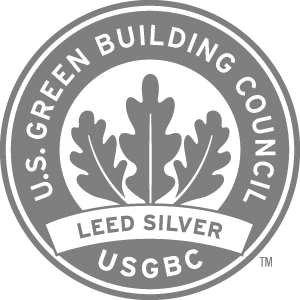At 100 years old, Baker College is among the oldest buildings on campus, but the recent renovation of the centenarian have it looking better than ever. Moreover, the green elements incorporated into the addition of the new wing have earned Rice its 10th certification from the U.S. Green Building Council’s Leadership in Energy and Environmental Design (LEED) program.
 LEED certification is an internationally recognized standard for the design, construction and operation of eco-friendly buildings. It is awarded to projects designed and built to universally accepted criteria for energy efficiency, material conservation, water efficiency, indoor environmental quality and stewardship of resources and sensitivity to their impacts.
LEED certification is an internationally recognized standard for the design, construction and operation of eco-friendly buildings. It is awarded to projects designed and built to universally accepted criteria for energy efficiency, material conservation, water efficiency, indoor environmental quality and stewardship of resources and sensitivity to their impacts.
“Baker is comprised of elements that range in age from 100 years old to less than 6 months old,” said Mark Ditman, associate vice president for housing and dining. “The historic wing was exceptionally well built, as evidenced by its present condition, and I expect the new wing to age just as gracefully. Our LEED Silver achievement will contribute to longevity, quality and cost-efficiency of the new wing.”
The project, which got under way in 2009, included a completely renovated kitchen/servery with a new computer room, coordinator’s office and community kitchen, and a new bed tower, which houses 108 students. The addition replaces the former kitchen and Housing and Dining Office; both were demolished and the materials were recycled.
Almost 90 percent of all construction and demolition waste during this process was recycled — a total of 2,188 cubic yards of waste was diverted from the landfill, according to Richard Johnson, Rice’s director of energy and sustainability and professor in the practice of environmental studies in sociology.
“Some will remember that when our first two green colleges opened – Duncan and McMurtry – they were home to students from Baker and Will Rice while their own colleges were being renovated. We applied many of the sustainability successes from the Duncan and McMurtry projects to the new additions at Baker and Will Rice, which is quite fitting, as when those students made their way back to their original colleges, they brought the sustainability story with them. This is all about providing students with high-quality healthy living spaces that are responsive to the natural resource constraints of the present and future.
Among the project’s sustainable highlights are:
— The windows are double-paned with low-e glass, which allows the light in but helps keep the summer heat out. This contributes to the building’s overall energy efficiency, which is more than 20 percent more efficient than conventional construction. Almost 92 percent of the building’s interior has access to natural daylight.
— The student rooms are equipped with bathroom “pods.” These 7-by-7-foot pods were prefabricated offsite, which minimized construction waste, and they were designed to be easily connected upon delivery to the project site, which saved construction time.
— Within the pods are water-efficient fixtures, including dual-flush toilets and low-flow shower heads. These fixtures help make the Baker College addition more than 40 percent more water-efficient than if traditional fixtures had been installed, according to Johnson. The water savings from toilets, sinks and showers is estimated at around 250,000 gallons per year.
— Student rooms were constructed using paints, adhesives and sealants with reduced emissions to provide for healthier indoor air quality. The rooms also feature concrete floors instead of carpet to prevent dirt and other potential irritants from becoming trapped.
— The lights in the student rooms operate using a motion/infrared-detection system that turns off the lights when the room is unoccupied.
— The heating and cooling system is designed to conserve energy and functions using Rice’s energy policy temperature guidelines. If the door is open, or if the room is unoccupied, the system enters a sleep mode to save energy.
“I think that incorporating LEED elements into the new addition was a smart move not only for the university, but for the students as well,” said Baker College senior Christina Hughes, who also is the head eco-rep at the college. “Energy- and water-saving designs such as improved insulation, light and temperature sensors and high-efficiency water fixtures will save the university, and ultimately the students, money. It is also a great way to expose students to the practicality of incorporating these elements into residential units and to the importance of these kinds of high-level sustainability initiatives.”
Sustainability at Baker isn’t limited to the brick and mortar; it’s designed to engender sustainable living too.
The kitchen, which was rebuilt concurrently with the addition, employs a farm-to-fork-to-farm program wherein the kitchen buys produce from a local farmer and sends back kitchen scraps for composting. The servery also is trayless, which helps cut down on food waste. The green roof of the kitchen serves as rainwater retention, solar insulation and wildlife habitat.
“There is a certain level of pride associated with living in a LEED-certified building and knowing that our university has made a commitment to incorporate such a high level of sustainability standards into future projects,” said Hughes.
In 2006, Rice set a goal that all new buildings would be certified as part of the USGBC’s LEED program for new construction.
Rice’s other LEED Silver certifications include Gibbs Recreation Center, Rice Children’s Campus, Wilson House and the Will Rice College addition. Rice earned LEED Gold certification for Duncan and McMurtry colleges, the Oshman Engineering Design Kitchen, the BioScience Research Collaborative and Brockman Hall for Physics.


Leave a Reply